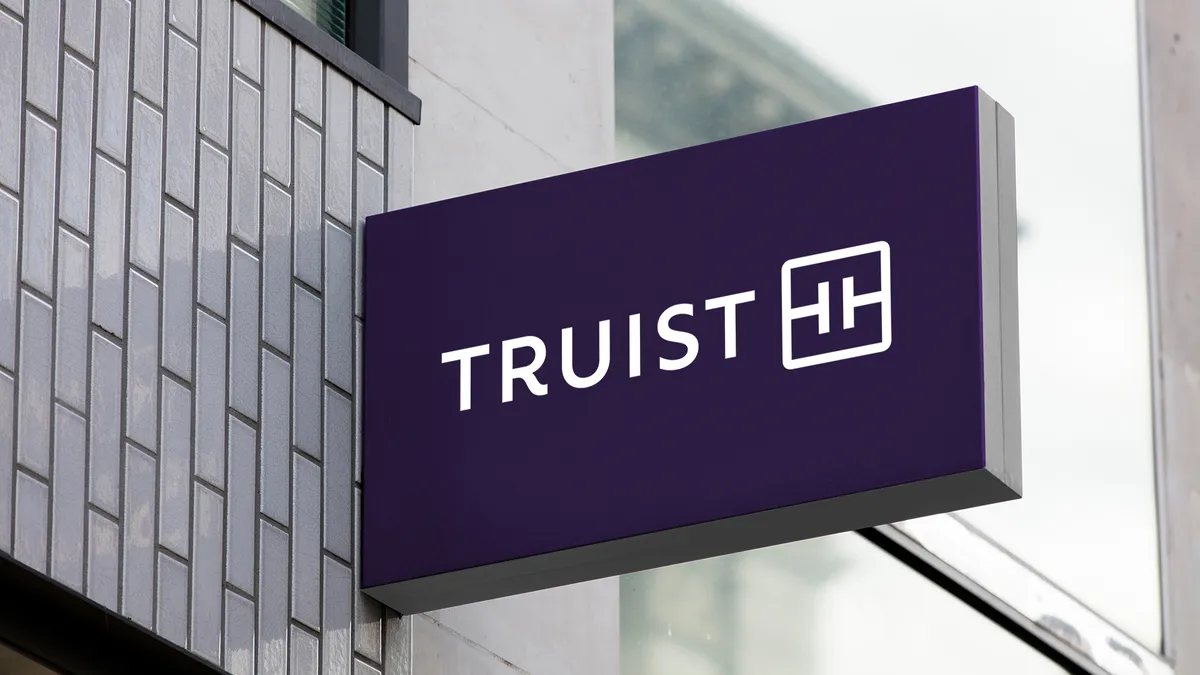Dive Brief:
- Profit at Truist was relatively flat for the first quarter of 2022, with the Charlotte, North Carolina-based bank reporting net income of $1.327 billion Tuesday, compared with the $1.334 billion it netted during the first three months of last year.
- The $544 billion-asset bank reported revenue of $5.33 billion during the quarter, a 2.9% drop from $5.5 billion it took in during last year’s comparable period.
- Truist Chairman and CEO Bill Rogers attributed the drop in revenue at the bank to the "challenging environment for investment banking and mortgage." However, he said, "we remain confident in our outlook given expectations for higher interest rates, our diverse business model, and continued expense discipline."
Dive Insight:
Rogers called the quarter ending March 31 a "historic one" for the bank, which was formed through the 2019 merger between SunTrust and BB&T.
Rogers said the bank completed its largest merger-related conversion during the quarter, transitioning nearly 7 million customers to the Truist ecosystem and rebranding more than 6,000 branches and ATMs to Truist.
"We now operate officially as one brand and one bank to our clients," he told analysts Tuesday. "We remain guided by our purpose as we continue supporting our clients through the transition and look forward to shifting our focus to executional excellence and purposeful growth throughout this year."
The bank described its merger integration as "substantially complete," though remaining tasks include teller platform migration and the decommissioning of three data centers.
"The integration was successful overall, especially when you consider the scale and complexity involved," said Rogers, calling it the largest bank technology integration in over 15 years.
The bank said it closed over 400 branches during the quarter, exceeding its commitment to close 800 locations by the first quarter of 2022.
The bank is on track to achieve $1.6 billion in annual net merger-related savings by this year's fourth quarter, CFO Daryl Bible said.
During the quarter, the bank reported $216 million in restructuring charges and $202 million in incremental operating expenses related to the $28 billion merger.
Truist One
Joining a host of financial institutions that have made changes to their overdraft policies in recent months, Rogers said Truist will discontinue a number of overdraft-related fees at the end of the month.
The bank also plans to launch its new Truist One checking account this summer, Rogers said.
The zero-overdraft-fee account will feature a $100 negative balance buffer and a deposit-based credit line limit up to $750.
"We're mindful of the impacts that inflation and reduced stimulus may have on certain segments of our clients, particularly in the least-advantaged, and Truist One is one of the many examples of where we're advancing financial inclusion," he said.
Truist released $95 million of its loan-loss reserves during the quarter, "primarily reflecting the continued favorable credit environment," the bank reported.
"Our reserve levels reflect current credit conditions, but also take into account uncertainty associated with inflation, rising rates and geopolitical events," Bible said Tuesday, adding the bank has no direct credit exposure and minimal indirect exposure to Russia or Ukraine.
Intentional flexibility
As employees returned to on-site work in March, Rogers said the bank implemented a work model focused on "intentional flexibility."
"Personally, it was just incredibly energizing to have so much in-person engagement over the last two months," Rogers said. "Whether with teammates, clients, community members or shareholders, hybrid and more flexible work is here to stay, but I'm pleased at how our teammates are embracing this new model."














